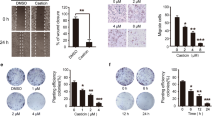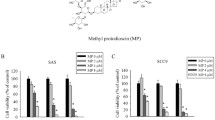Abstract
Purpose
The phosphoinositide-3-kinase (PI3K) pathway is the frequently altered in human cancer. This has led to the development and study of novel PI3K inhibitors for targeted therapy and also to overcome resistance to radiotherapy.
Method
The anti-tumour effects of PI3K inhibitors (PI-828, PI-103 and PX-866) in terms of cell proliferation, colony formation, induction of apoptosis, cell cycle arrest, invasion, autophagy, and pNF-κB/p65 translocation in SCC-4, SCC-9 and SCC-25 cells were studied by performing MTT, clonogenic, DAPI staining, propidium iodide staining, annexin-V binding, matrigel invasion, acridine orange staining and immuno-fluorescence assay. Western blot assay was performed to assess the alteration in the expression of various proteins.
Result
PI-828 and PI-103 treatment exhibited dose-dependent inhibition of growth and proliferation of OSCC cells with a concomitant induction of apoptosis, altered cell cycle regulation and decreased invasiveness (p < 0.01). PX-866 induced apoptosis, cell cycle arrest, autophagy and a significant decrease in the invasiveness of oral cancer cells as compared to untreated cells (p < 0.01). These compounds significantly reduced expression of COX-2, cyclin-D1 and VEGF in the treated cells besides cytoplasmic accumulation of pNF-κB/p65 protein. In addition to PI3Kα, inactivation of downstream components, i.e. Akt and mTOR was seen.
Conclusion
PI3K inhibitors such as PI-103, PI-828 and PX-866 may be developed as potential therapeutic agents for effective treatment of oral squamous cell carcinoma (OSCC) patients, associated with activated PI3K/Akt pathway.






Similar content being viewed by others
References
Elango JK, Gangadharan P, Sumithra S, Kuriakose MA (2006) Trends of head and neck cancers in urban and rural India. Asian Pac J Cancer Prev 7(1):108–112
Sankaranarayanan R, Masuyer E, Swaminathan R, Ferlay J, Whelan S (1998) Head and neck cancer: a global perspective on epidemiology and prognosis. Anticancer Res 18(6B):4779–4786
Jemal A, Siegel R, Ward E, Hao Y, Xu J, Murray T et al (2008) Cancer statistics, 2008. CA Cancer J Clin 58(2):71–96
Hennessy BT, Smith DL, Ram PT, Lu Y, Mills GB (2005) Exploiting the PI3K/AKT pathway for cancer drug discovery. Nat Rev Drug Discov 4(12):988–1004
Scheid MP, Woodgett JR (2001) PKB/AKT: functional insights from genetic models. Nat Rev Mol Cell Biol 2(10):760–768
Manning BD, Cantley LC (2007) AKT/PKB signaling: navigating downstream. Cell 129(7):1261–1274
Lui VW, Hedberg ML, Li H et al (2013) Frequent mutation of the PI3K pathway in head and neck cancer defines predictive biomarkers. Cancer Discov 3(7):761–769
Qiu W, Schönleben F, Li X et al (2006) PIK3CA mutations in head and neck squamous cell carcinoma. Clin Cancer Res 12(5):1441–1446
Sathiyamoorthy J, Sundar VS, Babu NA, Shanmugham S, Mani JG, Chinnaiyan P, Kalyanaraman A, Hari R (2018) Study on PIK3CA gene mutations in oral squamous cell carcinoma among South Indian populations. Biomed Pharmacol J. 11:2
Giudice FS, Squarize CH (2013) The determinants of head and neck cancer: unmasking the PI3K pathway mutations. J Carcinogene Mutagene S5:003
Wan X, Li X, Yang J et al (2015) Genetic association between PIK3CA gene and oral squamous cell carcinoma: a case control study conducted in Chongqing, China. Int J Clin Exp Pathol 8(10):13360–13366
Specenier P, Vermorken JB (2010) Advances in the systemic treatment of head and neck cancers. Curr Opin Oncol 22(3):200–205
da Silva SD, Hier M, Mlynarek A, Kowalski LP, Alaoui-Jamali MA (2012) Recurrent oral cancer: current and emerging therapeutic approaches. Front Pharmacol 3:149
Kioi M. Recent advances in molecular-targeted therapy for oral cancer (2017). Int J Oral Maxillofac Surg 46:27
Jung K, Kang H, Mehra R (2018) Targeting phosphoinositide 3-kinase (PI3K) in head and neck squamous cell carcinoma (HNSCC). Cancers of the Head Neck 3:3
Bendell CJ, Varghese AM, Hyman DM, Bauer TM, Pant S, Callies S et al (2018) A first-in-human phase 1 study of LY3023414, an oral PI3K/mTOR dual inhibitor, in patients with advanced cancer. Clin Cancer Res 24(14):3253–3262
Janku F (2017) Phosphoinositide 3-kinase (PI3K) pathway inhibitors in solid tumors: from laboratory to patients. Cancer Treat Rev 59:93–101
Fan Q-W, Knight ZA, Goldenberg DD, Yu W, Mostov KE, Stokoe D et al (2009) A dual PI3 kinase/mTOR inhibitor reveals emergent efficacy in glioma. Cancer Cell 9(5):341–349
Ihle NT, Paine-Murrieta G, Berggren MI, Baker A, Tate WR, Wipf P et al (2005) The phosphatidylinositol-3-kinase inhibitor PX-866 overcomes resistance to the epidermal growth factor receptor inhibitor gefitinib in A-549 human non-small cell lung cancer xenografts. Mol Cancer Ther 4(9):1349–1357
Aggarwal S, Sharma SC, Das SN (2015) Galectin-1 and galectin-3: plausible tumour markers for oral squamous cell carcinoma and suitable targets for screening high-risk population. Clin Chim Acta 442:13–21
Aggarwal S, Das SN (2016) Garcinol inhibits tumour cell proliferation, angiogenesis, cell cycle progression and induces apoptosis via NF-κB inhibition in oral cancer. Tumour Biol 37(6):7175–7184
Aggarwal S, Sharma SC, Das N S (2017) Dynamics of regulatory T cells (Tregs) in patients with oral squamous cell carcinoma. J Surg Oncol 116(8):1103–1113
Arora R, Bharti V, Gaur P, Aggarwal S, Mittal M, Das SN (2017) Operculina turpethum extract inhibits growth and proliferation by inhibiting NF-kB, COX-2 and cyclin D1 and induces apoptosis by up regulating P53 in oral cancer cells. Arch Oral Biol 80:1–9
Koul D, Shen R, Kim Y-W, Kondo Y, Lu Y, Bankson J et al (2010) Cellular and in vivo activity of a novel PI3K inhibitor, PX-866, against human glioblastoma. Neuro-oncology 12(6):559–569
Samuels Y, Wang Z, Bardelli A, Silliman N, Ptak J, Szabo S et al (2004) High frequency of mutations of the PIK3CA gene in human cancers. Science 304(5670):554
Trotman LC, Niki M, Dotan ZA, Koutcher JA, Di Cristofano A, Xiao A et al (2003) Pten dose dictates cancer progression in the prostate. PLoS Biol 1(3):E59
Wang S, Gao J, Lei Q, Rozengurt N, Pritchard C, Jiao J et al (2003) Prostate-specific deletion of the murine Pten tumor suppressor gene leads to metastatic prostate cancer. Cancer Cell 4(3):209–221
Nakatani K, Thompson DA, Barthel A, Sakaue H, Liu W, Weigel RJ et al (1999) Up-regulation of Akt3 in estrogen receptor-deficient breast cancers and androgen-independent prostate cancer lines. J Biol Chem 274(31):21528–21532
Li Q, Zhu G-D (2002) Targeting serine/threonine protein kinase B/Akt and cell-cycle checkpoint kinases for treating cancer. Curr Top Med Chem 2(9):939–971
Bell HS, Ryan KM (2005) Intracellular signalling and cancer: complex pathways lead to multiple targets. Eur J Cancer 41(2):206–215
Serra V, Markman B, Scaltriti M, Eichhorn PJA, Valero V, Guzman M et al (2008) NVP-BEZ235, a dual PI3K/mTOR inhibitor, prevents PI3K signaling and inhibits the growth of cancer cells with activating PI3K mutations. Cancer Res 68(19):8022–8030
Eichhorn PJA, Gili M, Scaltriti M, Serra V, Guzman M, Nijkamp W et al (2008) Phosphatidylinositol 3-kinase hyperactivation results in lapatinib resistance that is reversed by the mTOR/phosphatidylinositol 3-kinase inhibitor NVP-BEZ235. Cancer Res 68(22):9221–9230
Wymann MP, Bulgarelli-Leva G, Zvelebil MJ, Pirola L, Vanhaesebroeck B, Waterfield MD et al (1996) Wortmannin inactivates phosphoinositide 3-kinase by covalent modification of Lys-802, a residue involved in the phosphate transfer reaction. Mol Cell Biol 16(4):1722–1733
Walker EH, Pacold ME, Perisic O, Stephens L, Hawkins PT, Wymann MP et al (2000) Structural determinants of phosphoinositide 3-kinase inhibition by wortmannin, LY294002, quercetin, myricetin, and staurosporine. Mol Cell 6(4):909–919
Chen JS, Zhou LJ, Entin-Meer M, Yang X, Donker M, Knight ZA et al (2008) Characterization of structurally distinct, isoform-selective phosphoinositide 3′-kinase inhibitors in combination with radiation in the treatment of glioblastoma. Mol Cancer Ther 7(4):841–850
Chang L, Graham PH, Hao J, Ni J, Bucci J, Cozzi PJ et al (2014) PI3K/Akt/mTOR pathway inhibitors enhance radiosensitivity in radioresistant prostate cancer cells through inducing apoptosis, reducing autophagy, suppressing NHEJ and HR repair pathways. Cell Death Dis 5:e1437
Fan Q-W, Cheng CK, Nicolaides TP, Hackett CS, Knight ZA, Shokat KM et al (2007) A dual phosphoinositide-3-kinase alpha/mTOR inhibitor cooperates with blockade of epidermal growth factor receptor in PTEN-mutant glioma. Cancer Res 67(17):7960–7965
Park S, Chapuis N, Bardet V, Tamburini J, Gallay N, Willems L et al (2008) PI-103, a dual inhibitor of Class IA phosphatidylinositide 3-kinase and mTOR, has antileukemic activity in AML. Leukemia 22(9):1698–1706
Gwak H-S, Shingu T, Chumbalkar V, Hwang Y-H, DeJournett R, Latha K et al (2011) Combined action of the dinuclear platinum compound BBR3610 with the PI3-K inhibitor PX-866 in glioblastoma. Int J Cancer 128(4):787–796
Eskes R, Desagher S, Antonsson B, Martinou JC (2000) Bid induces the oligomerization and insertion of Bax into the outer mitochondrial membrane. Mol Cell Biol 20(3):929–935
Morselli E, Galluzzi L, Kepp O, Criollo A, Maiuri MC, Tavernarakis N et al (2009) Autophagy mediates pharmacological lifespan extension by spermidine and resveratrol. Aging (Albany NY) 1(12):961–970
Guillard S, Clarke PA, Te Poele R, Mohri Z, Bjerke L, Valenti M et al (2009) Molecular pharmacology of phosphatidylinositol 3-kinase inhibition in human glioma. Cell Cycle 8(3):443–453
Hussain AR, Ahmed SO, Ahmed M et al (2016) Cross-talk between NFkB and the PI3-kinase/AKT pathway can be targeted in primary effusion lymphoma (PEL) cell lines for efficient apoptosis. PLoS One 7(6):e39945
Jin HY, Lai M, Shephard J, Xiao C (2016) Concurrent PI3K and NF-κB activation drives B-cell lymphomagenesis. Leukemia 30:2267–2270
Syed DN, Afaq F, Kweon M-H, Hadi N, Bhatia N, Spiegelman VS et al (2007) Green tea polyphenol EGCG suppresses cigarette smoke condensate-induced NF-kappaB activation in normal human bronchial epithelial cells. Oncogene 26(5):673–682
Roskoski R (2007) Vascular endothelial growth factor (VEGF) signaling in tumor progression. Crit Rev Oncol Hematol 62(3):179–213
Ferrara N, Houck KA, Jakeman LB, Winer J, Leung DW (1991) The vascular endothelial growth factor family of polypeptides. J Cell Biochem 47(3):211–218
Dvorak HF, Brown LF, Detmar M, Dvorak AM (1995) Vascular permeability factor/vascular endothelial growth factor, microvascular hyperpermeability, and angiogenesis. Am J Pathol 146(5):1029–1039
Aggarwal S, Devaraja K, Sharma SC, Das SN (2014) Expression of vascular endothelial growth factor (VEGF) in patients with oral squamous cell carcinoma and its clinical significance. Clin Chim Acta 436:35–40
Chan G, Boyle JO, Yang EK, Zhang F, Sacks PG, Shah JP et al (1999) Cyclooxygenase-2 expression is up-regulated in squamous cell carcinoma of the head and neck. Cancer Res 59(5):991–994
Kapoor V, Singh AK, Dey S, Sharma SC, Das SN (2010) Circulating cycloxygenase-2 in patients with tobacco-related intraoral squamous cell carcinoma and evaluation of its peptide inhibitors as potential antitumor agent. J Cancer Res Clin Oncol 136(12):1795–1804
Garg R, Kapoor V, Mittal M, Singh MK, Shukla NK, Das SN (2013) Abnormal expression of PI3K isoforms in patients with tobacco-related oral squamous cell carcinoma. Clin Chim Acta 416:100–106
Martin KA, Blenis J (2002) Coordinate regulation of translation by the PI 3-kinase and mTOR pathways. Adv Cancer Res 86:1–39
Acknowledgements
The study was funded by Department of Science and Technology (DST), Government of India, under SERB Program. SA was recipient of senior research fellowship from Department of Science and Technology (DST), and SJ and LS were recipient of studentship from Department of Biotechnology, Government of India.
Author information
Authors and Affiliations
Corresponding author
Ethics declarations
Conflict of interest
The authors declare no competing financial interest.
Electronic supplementary material
Below is the link to the electronic supplementary material.
280_2018_3746_MOESM1_ESM.ppt
Supplementary Fig. 1: (a) Photomicrographs and (b) bar graphs as obtained after In vitro clonogenic assay indicating growth inhibitory effects of PI3K inhibitors (IC 50) treatment on oral cancer cell lines (SCC-4, SCC-9 and SCC-25 cells) (PPT 1397 KB)
280_2018_3746_MOESM2_ESM.ppt
Supplementary Fig. 2: Representative photomicrographs showing nuclear DNA fragmentation of PI-103, PI-828 and PX-866 treated SCC-4 cells in comparison to normal nuclear DNA in untreated SCC-4 cells (Blue: DAPI stain) (PPT 1629 KB)
Rights and permissions
About this article
Cite this article
Aggarwal, S., John, S., Sapra, L. et al. Targeted disruption of PI3K/Akt/mTOR signaling pathway, via PI3K inhibitors, promotes growth inhibitory effects in oral cancer cells. Cancer Chemother Pharmacol 83, 451–461 (2019). https://doi.org/10.1007/s00280-018-3746-x
Received:
Accepted:
Published:
Issue Date:
DOI: https://doi.org/10.1007/s00280-018-3746-x




